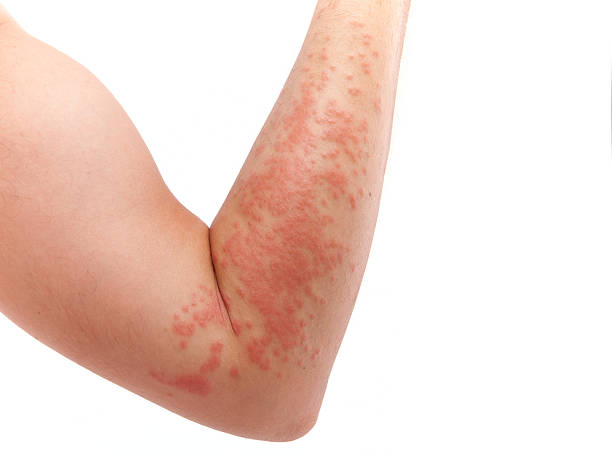9 Types Of Skin Allergies And Their Meanings

Arm covered in a skin allergy,hives
Skin allergies are a common and often perplexing phenomenon, leaving individuals grappling with discomfort and uncertainty.
From red rashes to persistent itching, the manifestations of skin allergies can vary widely.
Understanding the types of skin allergies and what they mean is essential for effective management and relief.

Let’s delve into the diverse world of skin allergies and decode the messages they convey.
1. Contact Dermatitis:
Meaning:
Contact dermatitis occurs when the skin comes into direct contact with an irritant or allergen. Common triggers include certain metals, cosmetics, fragrances, and plants like poison ivy.
READ ALSO: Body Language Etiquette: A Guide To Sitting, Standing, And Walking With Confidence
Symptoms:
Redness, itching, and sometimes blistering or oozing.
2. Atopic Dermatitis (Eczema):
Meaning:
Atopic dermatitis is a chronic condition often associated with genetic factors and immune system dysfunction. It tends to flare up periodically and is more common in individuals with a family history of allergies.
Symptoms:
Dry, itchy skin, red patches, and inflammation.
3. Urticaria (Hives)
Meaning:
Urticaria is characterized by raised, itchy welts on the skin. It can be triggered by various factors, including certain foods, medications, infections, or stress.
**Symptoms:**
Raised, red welts that may vary in size and shape.
4. Allergic Contact Dermatitis:
Meaning:
Allergic contact dermatitis is a delayed hypersensitivity reaction to an allergen. It can be caused by substances like certain metals, rubber, or preservatives in skincare products.
Symptoms:
Redness, itching, and swelling at the site of contact.
5. Psoriasis:
Meaning:
Psoriasis is a chronic autoimmune condition that speeds up the growth cycle of skin cells. It often appears as thick, red patches covered with silvery scales.
Symptoms:
Red patches with silvery scales, itching, and discomfort.
6. Angioedema:
Meaning:
Angioedema involves swelling in the deeper layers of the skin, often around the eyes and lips. It can be triggered by allergic reactions to medications or foods.
Symptoms:
Swelling of the deeper skin layers, which may be accompanied by pain.
7. Seborrheic Dermatitis:
Meaning:
Seborrheic dermatitis is a common, chronic condition affecting areas rich in oil glands. It can be exacerbated by stress, weather changes, and certain medical conditions.
Symptoms:
Red, scaly patches, often occurring on the scalp, face, and chest.
8. Drug Allergy:
Meaning:
Some individuals may develop allergic reactions to certain medications, ranging from mild rashes to severe, life-threatening conditions.
Symptoms:
Rash, hives, swelling, and in severe cases, difficulty breathing.
9. Dermatitis Herpetiformis:
Meaning:
Dermatitis herpetiformis is a skin manifestation of celiac disease. It presents as intensely itchy, red bumps and blisters.
Symptoms:
Itchy, blistering rash, often on the elbows, knees, buttocks, and back.
Understanding the specific type of skin allergy is crucial for effective management.
If you suspect a skin allergy, consult a healthcare professional for accurate diagnosis and tailored treatment options.
By deciphering the language of skin allergies, individuals can take proactive steps toward relief and long-term skin health.









